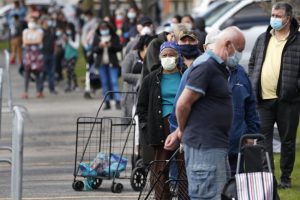
Hundreds of people wait in line for bags of groceries during a food pantry, sponsored by Healthy Waltham for those in need due to the COVID-19 virus outbreak, at St. Mary’s Church in Waltham,
WASHINGTON: The coronavirus crisis has sent U.S. unemployment surging to 14.7%, a level last seen when the country was in the throes of the Depression and President Franklin D. Roosevelt was assuring Americans that the only thing to fear was fear itself.
And because of government errors and the particular way the Labor Department measures the job market, the true picture is even worse. By some calculations, the unemployment rate stands at 23.6%, not far from the Depression peak of nearly 25%.
The Labor Department said Friday that 20.5 million jobs vanished in April in the worst monthly loss on record, triggered by the coast-to-coast shutdowns of factories, stores, offices and other businesses.
The breathtaking collapse is certain to intensify the push-pull across the U.S. over how and when to ease the stay-at-home restrictions. And it robs President Donald Trump of the ability to point to a strong economy as he runs for reelection.
“The jobs report from hell is here,” said Sal Guatieri, senior economist at BMO Capital Markets, “one never seen before and unlikely to be seen again barring another pandemic or meteor hitting the Earth.”
On Wall Street, stocks pushed higher as investors reckoned that the worst of the job losses are over. The Dow Jones Industrial Average gained more than 455 points, or close to 2%.
Worldwide, the virus has infected at least 3.9 million people and killed over 270,000, including more than 76,000 in the U.S., according to a tally by Johns Hopkins University based on official data.
The unemployment report indicated that the vast majority of those laid off in April — roughly 75% — consider their job loss temporary, a result of businesses that were forced to suddenly close but hope to reopen and recall their laid-off workers.
Whether most of those workers can return anytime soon, though, will be determined by how well policymakers, businesses and the public deal with the health crisis. Economists worry it will take years to recover all the jobs lost.
The meltdown has occurred with startling speed. In February, unemployment was at a more than 50-year low of 3.5%, and the economy had added jobs every month for a record 9 1/2 years. In March, unemployment was 4.4%.
“In just two months the unemployment rate has gone from the lowest rate in 50 years to the highest rate in almost 90 years,” said Gus Faucher, chief economist at PNC Financial.
Nearly all the job growth achieved during the 11-year recovery from the financial meltdown has now been lost in one month.
Leslie Calhoun lost his job cleaning Atlantic City, New Jersey, casinos after 20 years. He, his wife, their two daughters and his sister-in-law are surviving on his wife’s paycheck from a medical facility as he wrestles with an unemployment system that has paid him nothing since he applied in March.
“The bills are piling up,” he said. “We’re eating a lot of ramen noodles and hot dogs. What I wouldn’t give for a nice meal of baked chicken and steak, some fresh vegetables.”
The last time unemployment was this high was in 1939 at the tail end of the Depression, before the U.S. entered World War II.
Trump, who faces the prospect of high unemployment rates through the November elections, said the figures were “no surprise.”
“What I can do is I’ll bring it back,” he said. “Those jobs will all be back, and they’ll be back very soon. And next year we’ll have a phenomenal year.”
However, the nonpartisan Congressional Budget Office has projected that the jobless rate will still be 9.5% by the end of 2021.
As bad as Friday’s numbers were, they don’t capture the full magnitude of the devastation.
In a sort of footnote, the Labor Department acknowledged that its survey-takers erroneously classified millions of Americans as employed in April even though their employers had closed down. If they had been counted correctly, unemployment would have been nearly 20%, the government said.
However, the Labor Department doesn’t change the results submitted by its survey-takers because that could be seen as political manipulation.
Also, people who are out of work but aren’t actually looking for a new job are not officially counted as unemployed. An estimated 6.4 million people lost jobs last month but did not search for new ones, probably because they saw little prospect of finding work with the economy shut down.
Counting them as unemployed would push the rate up further, to almost 24%, according to calculations by Heidi Shierholz, an economist at the Economic Policy Institute.
Though some businesses are beginning to reopen in certain states, factories, hotels, restaurants, resorts, sporting venues, movie theaters and many small businesses are still largely shuttered. The government is dispensing nearly $3 trillion to help households and businesses pull through, including $1,200-per-person relief checks and an extra $600 in weekly unemployment benefits.
Trump has pushed aggressively to get businesses up and running again amid warnings from health experts that easing up too soon could lead to a deadly second wave of infections. As Election Day nears, the president will be judged on how he handles not just the economic crisis but the health one.
Just months ago, the Trump campaign planned to hammer its Democratic opponent this spring with negative ads while touting the strong economy. But since the outbreak, the re-election team has grown increasingly worried about the president’s standing in key states such as Michigan, Wisconsin and Florida. More than one-fifth of Michigan’s workers are on unemployment.
Former Vice President Joe Biden, meanwhile, has seized on the crisis as part of his overall attempt to cast Trump as caring only about the wealthiest Americans.
The health scourge has taken such a heavy economic toll around the world that economists have had to break out the history books.
This week, the Bank of England projected that Britain will see its biggest annual economic decline since 1706, when the European powers were embroiled in the War of the Spanish Succession.
Unemployment in the 19-country eurozone is expected to surpass 10% in coming months as more people are laid off. That figure is expected to remain lower than the U.S. rate, in part because millions of workers in places such as France and Germany are staying on the payrolls with the help of government aid that covers a large portion of their salaries.
Over the past seven weeks, an estimated 33.5 million American workers have filed for unemployment benefits. Friday’s job-loss report captures just five weeks, it is based on a mid-April survey of businesses and households, and it is a net figure — that is, it takes into account the offsetting effects of the hiring surge at companies like Amazon and many grocery stores
Harvard economist Raj Chetty said the economy’s health will hinge on when the outbreak has subsided enough that most Americans feel comfortable returning to restaurants, bars, theaters and shops.
Minorities and poor people have suffered the most from the shutdown. Job losses were especially severe among Latinos, whose unemployment rate leaped to 18.9% from 6% in March. The African-American rate jumped to 16.7%, while for whites it rose to 14.2%.

